Charming French actress Pascale Audret (1936-2000) starred in over 25 films between 1955 and 1968, but her success never crossed over internationally. One of her most high profile films was La Fayette (1961) opposite Orson Welles. Her daughter Julie Dreyfus was a co–star of Quentin Tarantino's Kill Bill (2003) and Inglourious Bastards (2009).
![Pascale Audret]()
French postcard by M.D., Paris, no. 15. Photo: Sam Lévin.
![Pascale Audret]()
French postcard by Editions P.I., Paris, no. 1029. Photo: Sam Lévin.
![Pascale Audret]()
French postcard by Editions du Globe, Paris, no. 15. Photo: Sam Lévin.
![Pascale Audret]()
Italian postcard by Rotalcolor, Milano, no. N. 119.
Pascale Audret was born as Pascale Aiguionne Louise Jacqueline Marie Auffray in Neuilly-sur-Seine, France, in 1936. She was the daughter of Henry Auffray, an industrialist, and Amyelle de Caubios d'Andiran, a musician, second cousin of the French author François Mauriac. Her brothers were singer Hugues Aufray, nicknamed ‘the French Bob Dylan’ during the 1960s, and author Jean-Paul Auffray.
Spending her childhood in Madrid in Spain, Audret studied classical dance. She appeared as a dancer in the stage operetta À la Jamaïque (To Jamaica) by Francis Lopez and then worked at the famous cabaret of Jacques Canetti, Les trois baudets (The Three Donkeys). There she was discovered by Roger Pierre, and at the age of 18, she made her film debut in Les deux font la paire/Two Makes a Pair (André Berthomieu, 1954) starring Jean Richard.
The next years she appeared in such films as Futures vedettes/Joy of Living (Marc Allégret, 1955) with Jean Marais, the film noir Œil pour œil/An Eye for an Eye (André Cayatte, 1956) with Curd Jürgens, and L'Eau vive/Girl and the River (François Villiers, 1958).
On stage she starred in 1956 in the first French production of Le Journal d'Anne Frank (The Diary of Anne Frank). It was a triumph for the charming young actress. After meeting her first husband Roger Coggio she went to work at the Théâtre des Mathurins and appeared in such plays as Le Journal d'un fou (The Diary of a Madman) by Nicolas Gogol, Patate (Spud) by Marcel Achard, and Six personnages en quête d'auteur (Six Characters in Search of an Author) by Luigi Pirandello.
![Pascale Audret]()
French postcard by Editions du Globe, Paris, no. 788. Photo: Studio Vauclair.
![Pascale Audret]()
French postcard by Editions du Globe, Paris, no. 724. Photo: Studio Harcourt.
![Pascale Audret]()
French postcard by Editions du Globe, Paris, no. 670. Photo: Sam Lévin.
![Pascale Audret]()
French postcard by Editions P.I., Paris, no. 898. Photo: Sam Lévin.
![Pascale Audret]()
Dutch postcard by Uitg. Takken, Utrecht, no. AX 4143. Photo: City Film. Publicity still for Bal de Nuit/Night Dance Hall (Maurice Cloche, 1959).
One of Pascale Audret’s most high profile films is the big-budget historical drama La Fayette/Lafayette (Jean Dréville, 1961) in which she appeared opposite Orson Welles. It is the colorful story of a Frenchman (Michel LeRoyer) who fought to liberate the American colonies from British rule.
The following year she starred in Donnez-moi Dix Hommes Desesperes/Give Me Ten Desperate Men (Pierre Zimmer, 1962), which was entered into the 12th Berlin International Film Festival. The films tells imaginary events on a kibbutz in Palestine, set in the period just before Israel gained its status as an independent nation.
In 1963 Audret appeared in the crime drama Le glaive et la balance/The Sword and the Balance (André Cayatte, 1963) starring Antony Perkins, and the brutal and purposefully harsh satire Les Carabiniers/The Soldiers (Jean-Luc Godard, 1963).
Audret also worked as a singer with such hits as Dis-moi qui jadis (Say to me who formerly) in 1968 and La môme Anita (The Kid Anita) in 1969. Despite her success in the cinema and her hit songs, this success never crossed over internationally. Her career in film, television, stage and music stayed in France.
Pascale Audret was married twice, first to actor-director Roger Coggio and later to music producer Francis Dreyfus (1965-1973). It was her second marriage that produced her daughter Julie. After the birth of her daughter in 1966, she put her career on the back burner.
During the 1970s she worked for TV, and also appeared in the films Le Fantôme de la liberté/The Phantom of Liberty (Luis Bunuel, 1974) and L'Amant de poche/Lover Boy (Bernard Queysanne, 1977). Her last film was the comedy Dieu que les femmes sont amoureuses/Oh God, Women Are So Loving (Michel Cheyko, Magali Clément, 1994) with Mathieu Carrière.
In 2000, Pascale Audret died in a road accident in Brive-la-Gaillarde, France, aged 63. She was in the passenger seat of a car being driven by actor Rémy Kirch, who was also killed in the car crash. Her daughter Julie Dreyfus is an actress now, who co-starred as Sofie Fatale in Kill Bill (Quentin Tarantino, 2003) and as Francesca Mondino in Inglourious Bastards (Quentin Tarantino, 2009).
![Pascale Audret]()
French postcard by E.D.U.G., Paris, no. 177. Photo: Sam Lévin.
![Pascale Audret]()
French postcard by St Anne, Marseille. Photo: Sam Lévin.
Pascale Audret and her brother Hugues Aufray sing Lisandre (ça fait peur aux oiseaux). Source: tontonmichel (YouTube).
Trailer for Le Fantôme de la liberté/The Phantom of Liberty (1974). Source: AajShubkoo (YouTube).
Sources: Céline Colassin (CinéArtistes - French), CineMemorial (French), Wikipedia and IMDb.
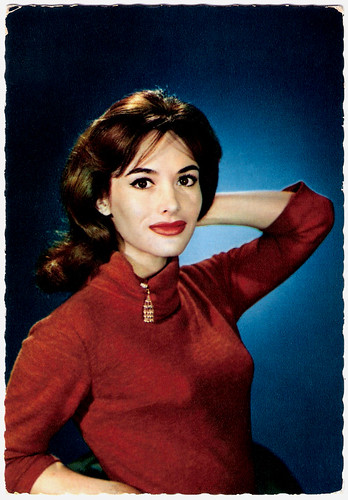
French postcard by M.D., Paris, no. 15. Photo: Sam Lévin.

French postcard by Editions P.I., Paris, no. 1029. Photo: Sam Lévin.
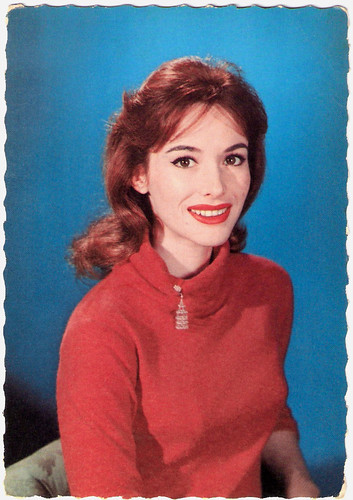
French postcard by Editions du Globe, Paris, no. 15. Photo: Sam Lévin.

Italian postcard by Rotalcolor, Milano, no. N. 119.
Triumph
Pascale Audret was born as Pascale Aiguionne Louise Jacqueline Marie Auffray in Neuilly-sur-Seine, France, in 1936. She was the daughter of Henry Auffray, an industrialist, and Amyelle de Caubios d'Andiran, a musician, second cousin of the French author François Mauriac. Her brothers were singer Hugues Aufray, nicknamed ‘the French Bob Dylan’ during the 1960s, and author Jean-Paul Auffray.
Spending her childhood in Madrid in Spain, Audret studied classical dance. She appeared as a dancer in the stage operetta À la Jamaïque (To Jamaica) by Francis Lopez and then worked at the famous cabaret of Jacques Canetti, Les trois baudets (The Three Donkeys). There she was discovered by Roger Pierre, and at the age of 18, she made her film debut in Les deux font la paire/Two Makes a Pair (André Berthomieu, 1954) starring Jean Richard.
The next years she appeared in such films as Futures vedettes/Joy of Living (Marc Allégret, 1955) with Jean Marais, the film noir Œil pour œil/An Eye for an Eye (André Cayatte, 1956) with Curd Jürgens, and L'Eau vive/Girl and the River (François Villiers, 1958).
On stage she starred in 1956 in the first French production of Le Journal d'Anne Frank (The Diary of Anne Frank). It was a triumph for the charming young actress. After meeting her first husband Roger Coggio she went to work at the Théâtre des Mathurins and appeared in such plays as Le Journal d'un fou (The Diary of a Madman) by Nicolas Gogol, Patate (Spud) by Marcel Achard, and Six personnages en quête d'auteur (Six Characters in Search of an Author) by Luigi Pirandello.
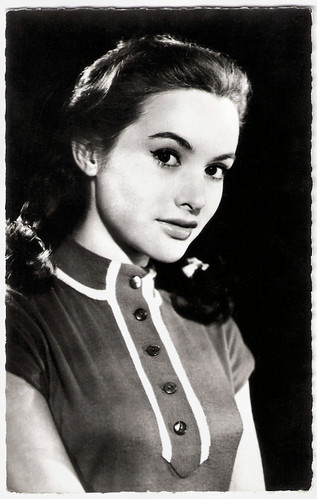
French postcard by Editions du Globe, Paris, no. 788. Photo: Studio Vauclair.
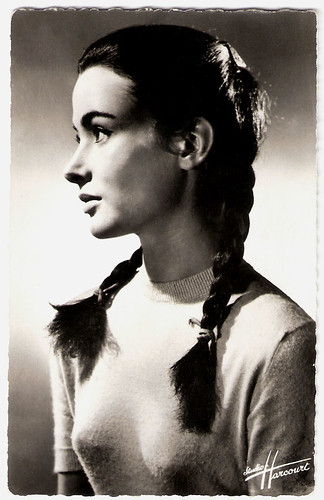
French postcard by Editions du Globe, Paris, no. 724. Photo: Studio Harcourt.

French postcard by Editions du Globe, Paris, no. 670. Photo: Sam Lévin.
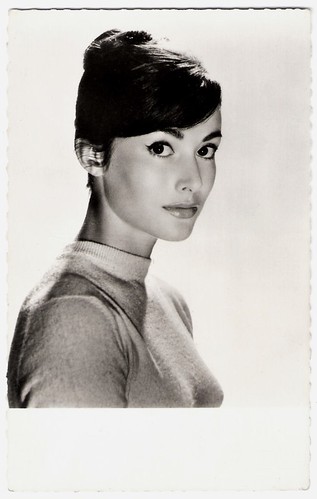
French postcard by Editions P.I., Paris, no. 898. Photo: Sam Lévin.
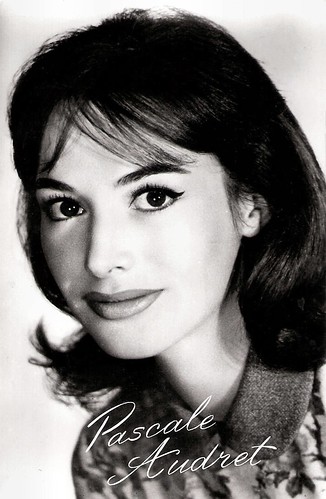
Dutch postcard by Uitg. Takken, Utrecht, no. AX 4143. Photo: City Film. Publicity still for Bal de Nuit/Night Dance Hall (Maurice Cloche, 1959).
Hit Songs
One of Pascale Audret’s most high profile films is the big-budget historical drama La Fayette/Lafayette (Jean Dréville, 1961) in which she appeared opposite Orson Welles. It is the colorful story of a Frenchman (Michel LeRoyer) who fought to liberate the American colonies from British rule.
The following year she starred in Donnez-moi Dix Hommes Desesperes/Give Me Ten Desperate Men (Pierre Zimmer, 1962), which was entered into the 12th Berlin International Film Festival. The films tells imaginary events on a kibbutz in Palestine, set in the period just before Israel gained its status as an independent nation.
In 1963 Audret appeared in the crime drama Le glaive et la balance/The Sword and the Balance (André Cayatte, 1963) starring Antony Perkins, and the brutal and purposefully harsh satire Les Carabiniers/The Soldiers (Jean-Luc Godard, 1963).
Audret also worked as a singer with such hits as Dis-moi qui jadis (Say to me who formerly) in 1968 and La môme Anita (The Kid Anita) in 1969. Despite her success in the cinema and her hit songs, this success never crossed over internationally. Her career in film, television, stage and music stayed in France.
Pascale Audret was married twice, first to actor-director Roger Coggio and later to music producer Francis Dreyfus (1965-1973). It was her second marriage that produced her daughter Julie. After the birth of her daughter in 1966, she put her career on the back burner.
During the 1970s she worked for TV, and also appeared in the films Le Fantôme de la liberté/The Phantom of Liberty (Luis Bunuel, 1974) and L'Amant de poche/Lover Boy (Bernard Queysanne, 1977). Her last film was the comedy Dieu que les femmes sont amoureuses/Oh God, Women Are So Loving (Michel Cheyko, Magali Clément, 1994) with Mathieu Carrière.
In 2000, Pascale Audret died in a road accident in Brive-la-Gaillarde, France, aged 63. She was in the passenger seat of a car being driven by actor Rémy Kirch, who was also killed in the car crash. Her daughter Julie Dreyfus is an actress now, who co-starred as Sofie Fatale in Kill Bill (Quentin Tarantino, 2003) and as Francesca Mondino in Inglourious Bastards (Quentin Tarantino, 2009).

French postcard by E.D.U.G., Paris, no. 177. Photo: Sam Lévin.
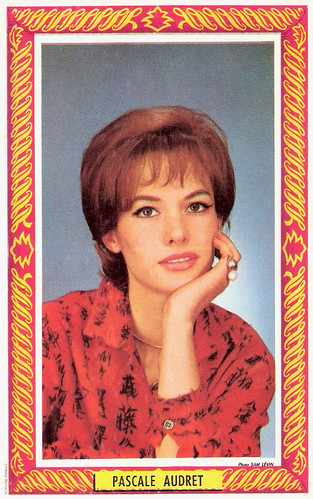
French postcard by St Anne, Marseille. Photo: Sam Lévin.
Pascale Audret and her brother Hugues Aufray sing Lisandre (ça fait peur aux oiseaux). Source: tontonmichel (YouTube).
Trailer for Le Fantôme de la liberté/The Phantom of Liberty (1974). Source: AajShubkoo (YouTube).
Sources: Céline Colassin (CinéArtistes - French), CineMemorial (French), Wikipedia and IMDb.